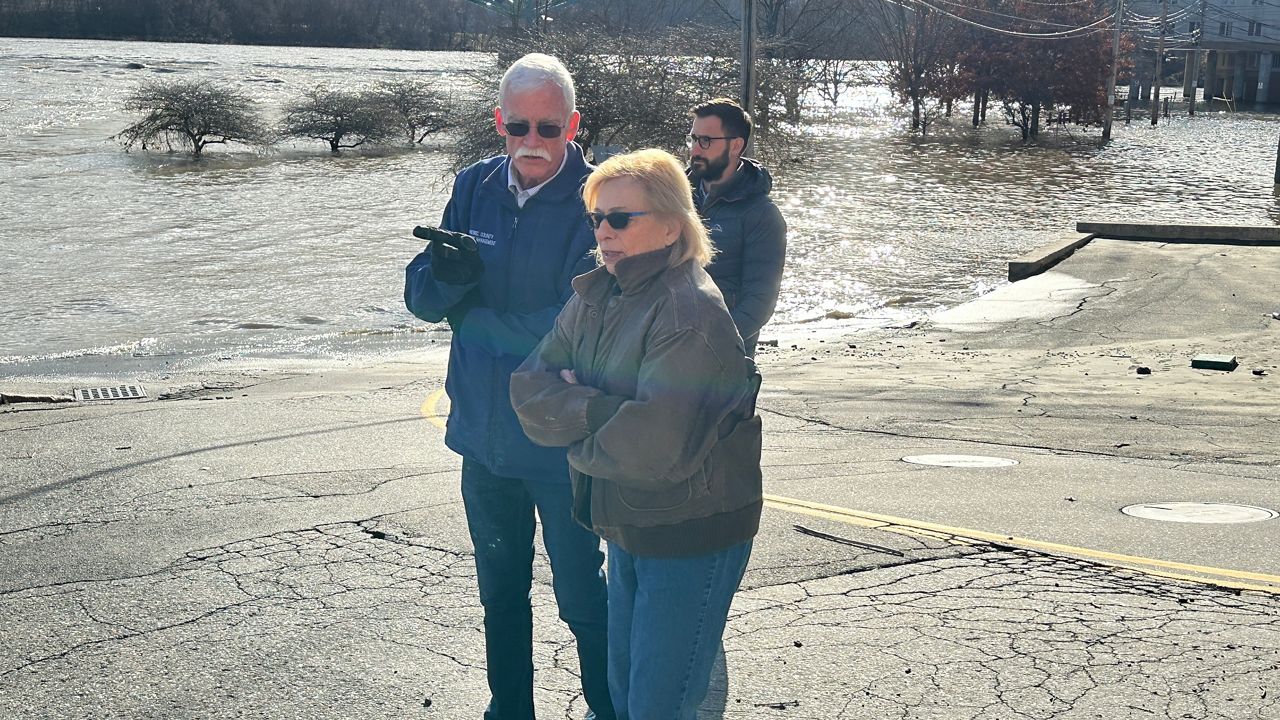Gov. Janet Mills defended her administration’s preparations before the Monday storm that devastated Maine, saying even weather forecasters didn’t accurately predict the amount of rain or severity of the wind that knocked out power to thousands.
“The National Weather Service did not predict 5-6 inches of rain in any community,” Mills said during a Wednesday press briefing. “The National Weather Service did not predict 68-70 mph winds.”
Mills said she did not see a reason to call in the National Guard for help at this point. And she said the Maine Emergency Management Agency took all the usual precautions before the storm.
“We’re as good as the weather reports,” Mills said. “We prepare for every storm and every emergency the same way.”
Her comments came following a tour of a flooded parking lot in downtown Augusta where she spoke with local emergency management officials as the Kennebec River raged behind her.
And though the river had dropped some from the previous day, water continued to splash against the backside of downtown buildings on Front Street.
On Monday, heavy rain in places like Oxford and Franklin counties washed out roads. Along the coast, wind gusts hit 70 mph, knocking out power to hundreds of thousands.
Two men died during the storm — one in Windham and another in Fairfield — while attempting to remove downed trees. At least two others went missing in Mexico when their car was swept away by the Swift River.
More than 400,000 Mainers lost power at some point during the storm, with about 245,000 continuing to be out as of Wednesday afternoon.
Cleanup has begun in many places, with downtown business owners assessing damage and public works crews scraping mud off streets in places like Hallowell.
And while caution signs blocked the main thoroughfare through the city, Maine Department of Transportation Commissioner Bruce Van Note said they ran out of signs in some places.
Mills said with such a big storm, it wasn’t possible to “put out signs in front of every pocket of water.”
Maine Emergency Management Agency Director Pete Rogers said Mainers should be aware that the state is likely to see more “multi-hazard events.”
Those events will include combinations of snow, wind, rain, coastal flooding and beach erosion, he said.
And if improvements can be made, they will determine that during discussions after the emergency subsides.
“We have after-actions after every single event we have,” he said.
Mills sent state workers home early Monday at the height of the storm and kept most offices closed Tuesday and Wednesday. Workers in York and Cumberland counties did report for work Wednesday, but Mills kept offices closed elsewhere.
In those 14 counties, Mills declared a Civil State of Emergency on Tuesday, which puts the state in line to receive federal aid in the coming weeks.
During the briefing, Mills said 68 state roads remained closed on Wednesday, about half of the high of more than 100. In addition, 23 bridges were closed, primarily because roads leading to the spans are not safe to travel.
She said she’s been in regular contact with the leaders of Central Maine Power and Versant Power and is confident they are doing all they can to restore electricity as quickly as possible.
“I think they are doing everything they can,” she said. “The flooding impeded their ability to get places.”
She emphasized what the power companies said immediately following the storm — that Mainers are in for a multi-day event.
She urged people to stay home if possible and reminded them not to drive through water and to listen to local officials.
“I understand how frustrating a situation it may be,” she said. “Please do not tempt fate.”
Mills recounted other recent disasters, including the COVID-19 pandemic, an unstable economy and the mass shootings in Lewiston that killed 18 and injured 13.
And she said while Christmas is just five days away, for many in Maine this year, it will be a difficult holiday season.
“We are never asked to carry more than we are able,” she said.








)